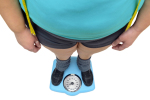|
2005/07/02, 11:21 PM
Even modest physical efforts can prove beneficial to weight loss. Leisurely distance walking, coupled with low-impact cardiovascular activity, appears to be a recipe for success among obese people looking to get into shape.
In a study, researchers tested 20 men and 20 women on treadmills and sidewalks; half were of normal weight and the rest had a body mass index (BMI) ranging from 30-40 (class 2 obese). Each participant's body composition was calculated using an instrument known as a DEXA scanner -- which measures fat mass, lean tissue mass and bone mineral content of the total body.
A unique treadmill that independently measures loads placed on the left and right feet while walking, as well as how the biomechanical forces increase with body weight and walking speed, was also used in the study.
The Results Showed ...
Those who walked 2 mph, compared to 3 mph, reduced the loads on their knee joints by up to 25 percent.
The number of calories burned per pound of body weight was similar for obese adults as normal weight adults who walked at the same speed.
Brisk walking can significantly increase the knee joint forces and set the stage for a variety of problems, including joint injuries and arthritis.
The overall goal of the study: By walking more slowly, obese individuals can burn more calories per mile and may reduce the risk of arthritis or joint injury. Further, since leisurely walking may not significantly improve cardiovascular fitness, taking part in other vigorous lower-impact activities such as swimming, cycling, step routines and elliptical training was also recommended.
Obesity Research May 2005;13(5):891-899...here is the study for any "eggheads". :big_smile:
Original Articles
Energetic Cost and Preferred Speed of Walking in Obese vs. Normal Weight Women
Raymond C. Browning and Rodger Kram
Department of Integrative Physiology, University of Colorado, Boulder, Colorado.
Address correspondence to Raymond Browning, Department of Integrative Physiology, 354 UCB, University of Colorado, Boulder, CO 80309-. E-mail: raymond.browning@colorado.edu
Objective: We tested the hypotheses that walking is more expensive for obese women, and they prefer slower walking speeds that minimize the gross energy cost per distance despite a greater relative aerobic effort .
Research Methods and Procedures: Twenty adult women, 10 obese (BMI = 34.1 ± 3.2 kg/m2) and 10 normal weight (BMI = 20.4 ± 2.1 kg/m2) volunteered. To determine the metabolic rate and energy cost per distance vs. speed relationships, we measured O2 and CO2 while subjects walked on a treadmill at six speeds (0.50, 0.75, 1.0, 1.25, 1.5, and 1.75 m/s; 5-minute trials, with a 5-minute rest period between trials). We measured preferred walking speed on a 50-m section of level sidewalk and O2max using a modified Balke treadmill protocol.
Results: Walking was 11% more expensive for the obese subjects, but they preferred to walk at similar speeds as normal weight subjects (1.40 vs. 1.47 m/s, p = 0.07). Both groups preferred walking speeds at which their gross energy cost per distance was almost minimized. Obese subjects had a smaller O2max/kg, so they required a greater relative aerobic effort at the preferred speed (51% vs. 36%, p = 0.001).
Discussion: Obese women preferred a walking speed that minimized energy cost per distance, even though this strategy required a greater relative aerobic effort than walking more slowly. Our results suggest that walking slower for a set distance may be an appropriate exercise recommendation for a weight management prescription in obese adults.
--------------
If you don't stand for something, you will fall for anything....
bb1fit@freetrainers.com
|





